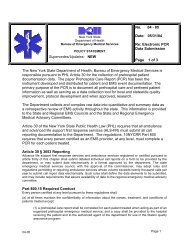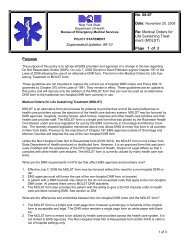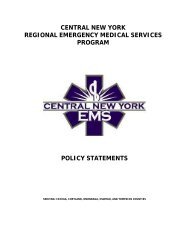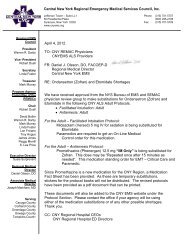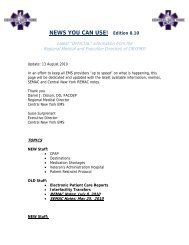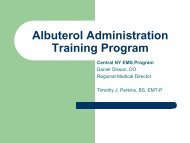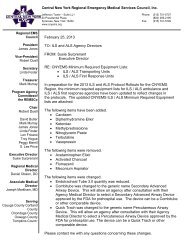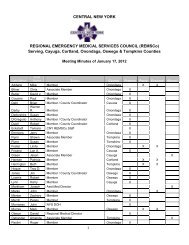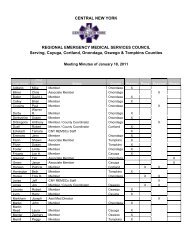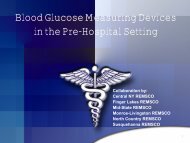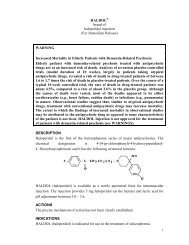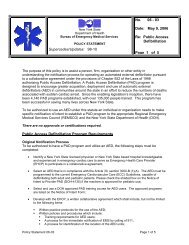Synthetic Cathinones (Bath Salts): An Emerging Domestic Threat
Synthetic Cathinones (Bath Salts): An Emerging Domestic Threat
Synthetic Cathinones (Bath Salts): An Emerging Domestic Threat
You also want an ePaper? Increase the reach of your titles
YUMPU automatically turns print PDFs into web optimized ePapers that Google loves.
U.S. Department of JusticeNational Drug Intelligence CenterSituation ReportJuly 2011Product Number 2011-S0787-004<strong>Synthetic</strong> <strong>Cathinones</strong> (<strong>Bath</strong> <strong>Salts</strong>): <strong>An</strong> <strong>Emerging</strong> <strong>Domestic</strong> <strong>Threat</strong>Cox Broadcasting.Executive SummaryThe National Drug Intelligence Center (NDIC) assesses with high confidence that the distributionand abuse of synthetic cathinones will increase in the United States in the near term, posingyet another challenge to U.S. law enforcement officials. Poison control centers and medicalprofessionals around the country are increasingly reporting patients suffering adverse physicaleffects associated with abuse of these drugs, further compounding the problem.Available data and law enforcement reporting suggest increasing levels of synthetic cathinoneavailability and abuse, but such information is limited and precise levels are unknown. U.S. Customsand Border Protection (CBP) currently tracks seizures of synthetic cathinones at U.S. portsof entry (POEs), but many synthetic cathinone products are disguised or mislabeled to impededetection. Because common field test kits, drug-detecting canines, and routine urine drug screensdo not detect synthetic cathinones, law enforcement officials are challenged in interdicting suchdrugs and prosecuting their manufacturers and distributors.
<strong>Synthetic</strong> <strong>Cathinones</strong> (<strong>Bath</strong> <strong>Salts</strong>): <strong>An</strong> <strong>Emerging</strong> <strong>Domestic</strong> <strong>Threat</strong><strong>Synthetic</strong> cathinones, typically marketed as “bath salts” and “plant food,” are sold legally undervarious names (Ivory Wave, Blizzard, etc.) in most areas of the United States. The productsare generally sold in retail establishments such as adult stores, independently owned conveniencestores, gas stations, head shops, and skateboard shops. The products, as well as their raw chemicalcomponents, are also sold on many Internet sites, including popular Internet auction sites. Additionally,synthetic cathinones have been sold by independent dealers as ecstasy a —in powderedform, in single-component tablets and capsules, and in tablets and capsules containing cathinonescombined with MDMA (3,4-methylenedioxymethamphetamine) or other illicit controlled substances.Abusers typically ingest, inhale, inject, smoke, or snort (insufflate) the drugs to experiencestimulant effects similar to those induced by amphetamine.Manufacturers and distributors of synthetic cathinone products evade U.S. Drug EnforcementAdministration (DEA) regulation and enforcement because synthetic cathinones are notscheduled under the Federal Controlled Substances Act (CSA). However, possession and distributionof the synthetic cathinones may be prosecuted, albeit with greater difficulty, under theFederal Controlled Substance <strong>An</strong>alogue Enforcement Act of 1986 (as amended) b of the CSA.The availability and suitability of a prosecution under the analogue statute depends on theparticular compound being trafficked and the facts of the case. Further, distributors deceptivelymarket synthetic cathinone products as “not for human consumption” to evade U.S. Food andDrug Administration (FDA) scrutiny. Cathinone products that are introduced into interstatecommerce and promoted as alternatives to illicit street drugs may be prosecutable under theFederal Food, Drug, and Cosmetic Act as unapproved new drugs and misbranded drugs. (Seethe offenses at 21 U.S.C. 331(a), (d) and penalties at 21 U.S.C. 333.) 1 Additionally, membersof the Congress have introduced legislation to nationally ban the sale of certain syntheticcathinones, c and, as of April 2011, all 50 states and the District of Columbia have introducedor announced plans to introduce legislation banning or restricting the distribution and possessionof certain synthetic cathinones and cathinone derivatives. As synthetic cathinones becomemore regulated, abusers will likely use the Internet with greater frequency to purchase cathinoneproducts, the raw chemicals used in their production, and products that contain cathinonesnot specifically prohibited by enacted legislation.a. Ecstasy tablets typically contain MDMA (3,4-methylenedioxymethamphetamine) but can contain various otherdrugs in place of or in combination with MDMA. Other drugs commonly identified in ecstasy include methamphetamine,amphetamine, BZP (N-benzylpiperazine), and caffeine.b. The Federal Controlled Substance <strong>An</strong>alogue Enforcement Act, enacted in 1986 as Pub. L. 99-570, title I, subtitleE, provides: “[a] controlled substance analogue shall, to the extent intended for human consumption, be treated .. . as a controlled substance in Schedule I.” The term “controlled substance analogue” is defined as a substance:(i) the chemical structure of which is substantially similar to the chemical structure of a controlled substance inschedule I or II; (ii) which has a stimulant, depressant, or hallucinogenic effect on the central nervous system thatis substantially similar to or greater than the stimulant, depressant, or hallucinogenic effect on the central nervoussystem of a controlled substance in schedule I or II; or (iii) with respect to a particular person, which such personrepresents or intends to have a stimulant, depressant, or hallucinogenic effect on the central nervous system thatis substantially similar to or greater than the stimulant, depressant, or hallucinogenic effect on the central nervoussystem of a controlled substance in schedule I or II.”c. S. 409, the “Combating Dangerous <strong>Synthetic</strong> Stimulants Act of 2011”.2
Product Number 2011-S0787-004National Drug Intelligence CenterBackground<strong>Synthetic</strong> cathinones are central nervous system stimulants. They are chemically similar tocathinone, a Schedule I controlled substance that occurs naturally in the khat 2 plant (Cathaedulis). The category of synthetic cathinones includes a number of drugs, such as MDPV(3,4-methylenedioxypyrovalerone) and mephedrone (which have been identified by theFDA Office of Criminal Investigations in illicit “bath salt” products; 3 see Appendix A) as wellas N-methylcathinone (also known as methcathinone or cat), 4 4-fluoromethcathinone (alsoknown as flephedrone or 4-FMC), 5 and 3,4-methylenedioxy-N-methylcathinone (also knownas methylone, MDMC, bk-MDMA, or M1). 6NDIC uses the term synthetic cathinone products to refer to synthetic cathinones packagedas authentic commercial products. These products include purported beauty and householdgoods such as “bath salt” products sold as Bliss, Blizzard, Blue Silk, Charge+, HurricaneCharlie, Ivory Snow, Ivory Wave, Ocean Burst, Pure Ivory, Purple Wave, Red Dove, SnowLeopard, Star Dust, Vanilla Sky, White Dove, White Knight, White Rush, and White Lightening.7 <strong>Synthetic</strong> cathinone products are also marketed as plant food/fertilizer, insect repellant,pond cleaner, and vacuum fresheners. 8<strong>Synthetic</strong> cathinones are commonly distributed in powder, crystal, and liquid forms, but theyare also available and abused in tablet and capsule forms. 9 Some synthetic cathinone tabletsand capsules have been marketed by distributers as ecstasy—forensic laboratories analyzingseized ecstasy tablets have reported that some tablets contain synthetic cathinones, alone or incombination with other drugs. 10 However, these tablets and capsules have not been marketed inretail outlets or on the Internet in conjunction with the more widely recognized “bath salts.” 11Abusers typically ingest, inhale, inject, smoke, or snort (insufflate) synthetic cathinone productsto experience effects similar to those of amphetamine abuse. Some abusers dissolvethe drugs in water or other solvents and proceed to atomize i and inhale them, while othersapply the solutions to their mucus membranes by placing drops in their eyes or spraying thesolutions in their noses. 12The term synthetic cathinone products, as used in this report, is not meant to refer to legalpharmaceuticals. The prescription drugs bupropion (Zyban®, Wellbutrin®), diethylpropion(Tenuate®), and pyrovalerone (Centroton®) are legal synthetic cathinone products—diethylpropionis a Schedule IV controlled substance, and pyrovalerone is a Schedule V controlledsubstance under the Federal CSA.i. Atomizers are devices that use heat, pressure, or vibration to convert a liquid into a vapor or an aerosol mist so it can be inhaled and absorbedthrough the lungs. Electronic cigarettes are a common type of atomizer that uses heat. Nebulizers—often used by individuals with respiratorydisorders and diseases—use vibration or pressure.3
<strong>Synthetic</strong> <strong>Cathinones</strong> (<strong>Bath</strong> <strong>Salts</strong>): <strong>An</strong> <strong>Emerging</strong> <strong>Domestic</strong> <strong>Threat</strong><strong>Synthetic</strong> Cathinone Availability and AbuseNDIC assesses with high confidence that the availability of synthetic cathinone products in theUnited States is high.State and local law enforcement information indicates that synthetic cathinone productsare readily available in retail establishments and over the Internet, and some local independentdealers sell the products. <strong>Synthetic</strong> cathinone products, most marketed as “bath salts,”are distributed across the country in small, independently owned retail establishments such asadult stores, independently owned convenience stores, gas stations, head shops, and skateboardshops. 13 The products, as well as their raw chemical components, are also sold on many Internetsites, including popular Internet auction sites and global marketing sites. 14 The products aretypically “branded” under the names previously listed. Some local independent drug dealers alsodistribute the products directly to users. 15Available seizure information indicates that significant quantities of synthetic cathinonesand synthetic cathinone products are shipped to the United States from foreign countries.CBP seized many shipments of synthetic cathinones and synthetic cathinone products at U.S.POEs from July 2009 through April 2011; the products were laboratory tested and found to containMDPV, mephedrone, and other synthetic cathinones that have not yet been identified in syntheticcathinone products distributed in the United States. 16 <strong>Synthetic</strong> cathinone products are often packagedin such a way that they appear to be authentic beauty and household goods. 17 As such, theypose a particular challenge for law enforcement officials in detection and interdiction efforts.<strong>Cathinones</strong> are sometimes sold in combination with other synthetic drugs or marketed asdifferent drugs altogether.• In January 2011, the Centralia (MO) Police Department arrested three men in a school parkinglot after they attempted to sell “Bliss,” a synthetic cathinone product mixed with methamphetamine,to an undercover officer. The ⅛-ounce powdered mixture was priced at $200. 18• In September 2010, the San Luis Obispo (CA) Sheriff’s Department reported that two15-year-old boys who thought they were consuming MDMA fell violently ill and developedsmall holes in their lungs after consuming mephedrone. The two boys also experiencedsymptoms of sore throat, violent vomiting, euphoria, elevated body temperature,and agitation. A nearby university student was arrested and charged with child endangermentand selling a narcotic substance to the teens. 19 Later that same month, the universitystudent’s mother was arrested after an investigation revealed that she had accepted andsigned for a 2-pound package of mephedrone that had originated in China and had beendelivered by the U.S. Postal Service. 20<strong>Synthetic</strong> cathinone abuse has caused users throughout the country to experience severe adverseeffects, and the number of “bath salt” calls to U.S. poison control centers has trendedupward. On December 21, 2010, the American Association of Poison Control Centers (AAPCC)issued its first warning regarding the dangers of synthetic cathinone abuse, particularly for productsmarketed as “bath salts.” The warning informed the public that as of that date, at least 156 dd. While the warning indicated at least 156 calls had occurred as of December 21, 2010, the AAPCC reported onMay 12, 2011, that 302 “bath salt” calls were ultimately recorded for 2010.4
Product Number 2011-S0787-004National Drug Intelligence Center“bath salt”-related calls had occurred in 2010—85 from Louisiana alone. Effects reported to thecenters included increased blood pressure, increased heart rate, agitation, hallucinations, extremeparanoia, and delusions; no deaths were reported. 21 The Louisiana Department of Health andHospitals also issued a warning regarding synthetic cathinones (bath salts), mentioning severalsymptoms experienced by hospitalized patients in addition to those mentioned above, includingchest pain, headache, and suicidal thoughts. 22 From January 1 through May 12, 2011, the AAPCCreceived 2,237 “bath salt”-related calls from poison control centers in 47 states and the Districtof Columbia—a significant increase from the 302 calls recorded for all of 2010. 23 (See Table 1.)Table 1. “<strong>Bath</strong>-Salt”-Related Calls Reported toU.S. Poison Control CentersYearNumber of Calls2009 02010 3022011* 2,237Source: American Association of Poison Control Centers, data run by AAPCC onMay 12, 2011.*Data reflect calls received and reported from January 1, 2011, through May 12, 2011.<strong>Synthetic</strong> cathinones are used by a geographically and demographically diverse abuserpopulation. No current U.S. population, household, or user survey contains questions regardingsynthetic cathinones or synthetic cathinone products, but some indicators suggest the demandfor and use of synthetic cathinone products are widespread. The AAPCC has issued multiple“bath salt abuse” press releases since December 2010, state health departments are posting “bathsalt” warnings on their web sites, 24 and state e, 25 and local f governments are introducing legislationand ordinances to reduce the availability of synthetic cathinones in their areas. 26 In addition,DEA National Forensic Information System (NFLIS) is receiving increasing reports of syntheticcathinone seizures. In 2009, NFLIS received 14 reports of analyzed seizures related to syntheticcathinones from 8 states; however, in 2010, NFLIS received 290 reports of analyzed seizuresfrom 21 states. 27 The AAPCC reports that “bath salts” abuse patients seeking medical attentionrange from teenagers to those in their 40s. 28 Moreover, synthetic cathinone abusers likely areindividuals who seek stimulant effects similar to those produced by cocaine, amphetamine/methamphetamine(illicit and prescription), and MDMA. 29<strong>Synthetic</strong> cathinones abusers likely are attracted to the drugs because they can evademost drug testing. Most current routine drug testing screens do not detect the presence ofsynthetic cathinones. Consequently, the drugs may appeal to some abusers who are subject tomandatory drug testing. While synthetic cathinones are not detected by routine screens, g, 30 somecommercial drug testing laboratories are beginning to offer specialized synthetic cathinonee. As of May 4, 2011, according to the National Conference of State Legislatures, a total of 15 states had taken actionto ban at least one of the chemicals used in drugs labeled as “bath salts,” either through legislative or administrativeaction; and 31 state legislatures have introduced legislation to restrict these substances.f. Contact your county government for local “bath salt” ordinances.g. Most drug testing companies offer an expanded test that includes a few additional drugs in the testing process. Typicallythe tests will look for a few of the following: ethanol (alcohol), hydrocodone (Lortab, Vicodin), barbiturates,methaqualone (Quaaludes), methadone, benzodiazepines (e.g., Valium), MDMA (ecstasy), propoxyphene (Darvon).5
<strong>Synthetic</strong> <strong>Cathinones</strong> (<strong>Bath</strong> <strong>Salts</strong>): <strong>An</strong> <strong>Emerging</strong> <strong>Domestic</strong> <strong>Threat</strong>testing. 31 One commercial toxicology laboratory offers two “designer stimulant drug test” panels—onefor MDPV and mephedrone and one for an expanded panel of 14 synthetic stimulants. 32<strong>Synthetic</strong> cathinone abusers who operate motor vehicles while under the influence willlikely go undetected during traffic stops unless toxicology testing for the drugs is specificallyrequested. Many synthetic cathinones produce stimulant effects that appear to be similar tococaine, amphetamines/methamphetamine, and MDMA. As such, abusers who operate motor vehiclesafter using synthetic cathinones likely present similar dangers as those who operate motorvehicles while under the influence of controlled stimulants. However, the presence of syntheticcathinones in the systems of these “drugged drivers” likely will go undetected if they are stoppedfor a traffic offense unless the officer making the stop is aware of the signs of stimulant abuseand orders a specialized synthetic cathinone laboratory test.<strong>Synthetic</strong> Cathinone Production and Distribution<strong>Synthetic</strong> cathinone products are manufactured internationally. According to very limiteddomestic and European law enforcement reporting, synthetic cathinones are synthesized primarilyin foreign countries, including China, India, and Pakistan. <strong>Cathinones</strong> are generally synthesizedby rogue chemists in foreign countries and are shipped directly to distributors or acquiredby distributors and abusers over the Internet. The United Kingdom has been identified as aprincipal transit country of some synthetic cathinones destined for the United States. 33 <strong>Synthetic</strong>cathinones are also marketed and sold on international and domestic web sites. 34<strong>Synthetic</strong> cathinones are deliberately labeled and marketed to circumvent sales restrictionsand evade prosecution. Manufacturers and distributors often advertise synthetic cathinoneproducts as bath salts or plant food that are “not for human consumption” to evade FDA scrutiny.35 However, if synthetic cathinone products are marketed or sold with the inference that theyare “legal cocaine, methamphetamine, MDMA, LSD, etc.,” they can be regulated by the FDAas street drug alternatives. 36 The FDA considers any product that is promoted as a street drug alternativeto be an unapproved new drug and a misbranded drug in violation of the Federal Food,Drug, and Cosmetic Act. 37 In addition, synthetic cathinones are not scheduled under the FederalCSA; however, possession and distribution of the synthetic cathinones may be prosecuted, albeitwith greater difficulty, under the CSA’s <strong>An</strong>alogue Enforcement Act of 1986 (as amended), whichstates that the controlled substance analogues shall, “to the extent intended for human consumption,”be treated as Schedule I controlled substances.<strong>Synthetic</strong> Cathinone Legislation and RegulationsState and local governments are adopting legislation and local ordinances to reduce theavailability of synthetic cathinones in their jurisdictions, and members of the United StatesCongress have introduced legislation to nationally ban the sale of certain synthetic cathinonesh . As of May 2011, all 50 states and the District of Columbia had introduced legislation torestrict or ban some synthetic cathinones and cathinone derivatives. 38 Some legislation placesspecific cathinones on state lists of controlled substances. 39 Additionally, some local governmentsare banning synthetic cathinones or synthetic cathinone products ahead of state legislatures. Asstate legislation and local ordinances are enacted, abusers will likely travel to neighboring areash. S. 409, the “Combating Dangerous <strong>Synthetic</strong> Stimulants Act of 2011.”6
Product Number 2011-S0787-004National Drug Intelligence Centerwithout such legislation or ordinances to purchase synthetic cathinone products or acquire themvia the Internet.The DEA is gathering information on the pharmacology, toxicity, and abuse of syntheticcathinones and synthetic cathinone products to support possible scheduling under the FederalCSA. On March 31, 2011, the Drug and Chemical Evaluation Section (ODE) of the DEA Officeof Diversion Control issued a public request for information on the following synthetic cathinones:• MDPV synonym 3,4-methylenedioxyprovalerone• Mephedrone synonyms 4-methylmethcathinone, 4-MMC• Methylone synonyms 3,4-methylenedioxymethcathinone, MDMC• Naphyrone synonyms napthylpyrovalerone, NRG-1• 4-Fluoromethcathinone synonyms 4-FMC, flephedrone• 3-Fluoromethcathinone synonym 3-FMC• Methedrone synonyms 4-methoxymethcathinone, BK-PMMA, PMMC• Butylone synonyms bk-MBDB, beta-keto-N-methylbenzodioxolylpropylamine<strong>An</strong>y information collected pursuant to ODE’s request, particularly that related to law enforcementencounters, drug identification, toxicology reports, medical examiner reports, and abusewill be used to support appropriate administrative modification to the drug schedules—or proposedstatutory revisions to the CSA—to include synthetic cathinones, if warranted.Use of synthetic cathinones by members of the U.S. Armed Forces is prohibited. U.S. ArmedForces’ offices have distributed general orders 40 prohibiting the use of intoxicating substances—substances that are inhaled, injected, consumed, or otherwise introduced into the body for the purposeof becoming intoxicated, high, altering mood or function, or achieving a psychoactive effect.Abuse of synthetic cathinones violates this order. Failure to obey this general order is a violation ofArticle 92, Uniform Code of Military Justice (UCMJ), and may result in disciplinary or administrativeaction including, but not limited to, trial by military court-martial, nonjudicial punishments underArticle 15 of the UCMJ, reprimand, admonishment, administrative demotion, security clearancerevocation, and involuntary separation with an adverse characterization of service.OutlookNDIC assesses with high confidence that the distribution and abuse of synthetic cathinonesin the United States will increase in the near term. As of the date of this report, syntheticcathinone-related calls to U.S. poison control centers continue to increase. Despite previouslydescribed legislation and orders, no substantial law enforcement or regulatory action has significantlyprevented synthetic cathinone products from reaching distributors or consumers, partlydue to availability of the chemicals, drugs, and products on the Internet. Until effective policiesbecome widespread and applied consistently and enforcement and regulatory actions begin toeffect the supply-demand balance, demand for the products will continue to fuel their productionand distribution.7
<strong>Synthetic</strong> <strong>Cathinones</strong> (<strong>Bath</strong> <strong>Salts</strong>): <strong>An</strong> <strong>Emerging</strong> <strong>Domestic</strong> <strong>Threat</strong>NDIC assesses with high confidence that more synthetic cathinones will be abused in thelong term. Dozens of different synthetic cathinones have been developed, but only 12 have beenseized and publicly identified. 41 Other synthetic cathinones are likely to be exploited in reformulatedproducts or as new products. The vast profit margin associated with these products and theability of manufacturers and traffickers to sidestep international chemical regulations will inevitablyincrease the availability of these drugs and their marketing to susceptible abusers.As commercial drug testing companies develop drug screens to detect synthetic cathinoneabuse, different synthetic cathinones will surface. Commercial drug testing companies aredeveloping drug screens to detect certain synthetic cathinones. However, because many distinctsynthetic cathinones exist and their metabolism in the human body is not fully understood, thetimely development of these tests will be difficult and the accuracy of initially developed testswill be limited. As tests are developed to screen for and detect the presence of the currentlyidentified synthetic cathinones, manufacturers will synthesize additional synthetic cathinones,as manufacturers have done with other synthetic drugs. For instance, in response to testing andenforcement efforts, manufacturers of synthetic cannabinoids introduced lesser-known JWH-019after widely used JWH-018 was able to be detected by tests and law enforcement placed pressureon manufacturers and distributors. 42 (JWH-018 and JWH-019 are synthetic cannabinoids.)The global nature of Internet chemical sales, particularly of synthetic cathinones, will presentincreasing challenges to U.S. law enforcement in the long term. If distribution of specificsynthetic cathinones is successfully controlled in the United States through appropriate administrativecontrol actions and legislation, producers will market other, unregulated synthetic cathinonesand chemicals, particularly through the Internet and global shipping networks. Long-termcontrol of synthetic cathinones will require significant international cooperation and coordinatedenforcement efforts.8
Product Number 2011-S0787-004National Drug Intelligence CenterAppendix A. Common <strong>Synthetic</strong> <strong>Cathinones</strong>Mephedrone (commonly known as 4-MMC, Bubbles, Drone, M-Cat, Meow Meow, and Meph)typically has little or no odor. 43 It is commonly available as a fine, white, off-white, or yellowishpowder; in crystal form; as a tablet; or in capsules. 44 Mephedrone is sold in retail (1, 5, or 10grams) and/or in bulk quantities. Effects are usually experienced 15–45 minutes after ingestedand last approximately 2–5 hours. After snorting, effects are usually experienced in 30 minutesand last approximately 2–3 hours. After an intravenous injection, the effects last approximately10–30 minutes. 45MDPV is a drug variant of pyrovalerone and was first detected in Germany in 2007. 46 It iscommonly available as a gray-colored substance with a granular consistency (the chemical formof its free base), a white powder (hydrochloride salt form), or as a tablet. Effects usually occur15–30 minutes after ingestion and last approximately 2–7 hours. After snorting, effects are usuallyexperienced in 5–20 minutes and last approximately 2–3.5 hours. Abuse of pyrovalerone hasbeen reported in drug addicts, 47 so MDPV addiction may be possible.9
<strong>Synthetic</strong> <strong>Cathinones</strong> (<strong>Bath</strong> <strong>Salts</strong>): <strong>An</strong> <strong>Emerging</strong> <strong>Domestic</strong> <strong>Threat</strong>10
Product Number 2011-S0787-004National Drug Intelligence CenterAppendix B. Scope and MethodologyScope: This situation report examines the threat that synthetic cathinone abuse poses to theUnited States and the difficulty that U.S. law enforcement faces in preventing the manufactureand distribution of synthetic cathinones and synthetic cathinone products. This report does notexamine the threat posed by prescription drugs that contain cathinones.Source Summary Statement: The analysis in this situation report is primarily derived fromdata posted publicly by official U.S. and European Union Government agencies and internationalorganizations, as well as studies published in peer-reviewed journals. The NDIC regards thesesources as highly reliable and authoritative.The cutoff date for all source reporting used in this assessment is May 18, 2011.High Confidence generally indicates that judgments are based on high-quality informationfrom multiple sources, from a single highly reliable source, or that the nature of the issue makesit possible to render a solid judgment. Medium Confidence generally means that the informationis credibly sourced and plausible, but can be interpreted in various ways or is not of sufficientquality or corroborated sufficiently to warrant a higher level of confidence. Low confidencegenerally means that the information’s credibility or plausibility is questionable, the informationis too fragmented or poorly corroborated to make solid analytic inferences, or that NDIC hassignificant concerns or problems with the sources.11
<strong>Synthetic</strong> <strong>Cathinones</strong> (<strong>Bath</strong> <strong>Salts</strong>): <strong>An</strong> <strong>Emerging</strong> <strong>Domestic</strong> <strong>Threat</strong>12
Product Number 2011-S0787-004National Drug Intelligence CenterEndnotes1. Food and Drug Administration (FDA), Guidance for Industry: Street Drug Alternatives, March 2000,www.fda.gov/downloads/Drug/GuidanceComplianceRegulatoryInformation/Guidances/ucm07043.pdf>, accessed March 2, 2011.2. Drug Enforcement Administration (DEA), Drugs and Chemicals of Concern: Khat (Street Names: Khat, Qat,Kat, Chat, Miraa, Quaadka), , June 2009, accessedMarch 2, 2011.3. FDA, Office of Criminal Investigations, January 26, 2011.4. DEA, “Methcathinone.” < www.justice.gov/dea/concern/methcathinone.html >, accessed March 2, 2011.5. Archer, R.P., “Fluoromethcathinone, a new substance of abuse.” Forensic Science International, March 10,2009; Brandt, S.D., “<strong>An</strong>alyses of second-generation ‘legal highs’ in the UK: initial findings,” Drug Testing and<strong>An</strong>alysis, August 5, 2010.6. Bossong, M.G., et al., “Methylone and mCPP, two new drugs of abuse?,” Addict Biology, December 2005.7. Department of Justice Press Release, “DEA to Host Media Roundtable on <strong>Synthetic</strong> Drugs,” February 11, 2001.8. DEA Media Roundtable on <strong>Synthetic</strong> Drugs, February 16, 2011.9. DEA, “<strong>Synthetic</strong> <strong>Cathinones</strong>-DEA Request for Information,” March 31, 2011.10. Georgia Bureau of Investigation via NDIC SENTRY submission, Tracking Number: E0000005432, submittedNovember 4, 2010.11. DEA Media Roundtable on <strong>Synthetic</strong> Drugs, February 16, 2011.12. DEA, “<strong>Synthetic</strong> <strong>Cathinones</strong>-DEA Request for Information,” March 31, 2011.13. DEA, “<strong>Synthetic</strong> <strong>Cathinones</strong>-DEA Request for Information,” March 31, 2011.14. DEA Media Roundtable on <strong>Synthetic</strong> Drugs, February 16, 2011.15. Centralia (MO) Police Department, News Release, January 29, 2011; Follow-up emails between National DrugIntelligence Center (NDIC) Intelligence <strong>An</strong>alyst and Centralia Police Chief, January 31, 2011.16. Customs and Border Protection (CBP), Data Provided to NDIC in Response to Request for <strong>Synthetic</strong> CathinoneSeizures at U.S. Ports of Entry, RFI 2011-054, January 31, 2011.17. DEA Media Roundtable on <strong>Synthetic</strong> Drugs, February 16, 2011.18. Centralia (MO) Police Department, News Release, January 29, 2011; Follow-up emails between National DrugIntelligence Center (NDIC) Intelligence <strong>An</strong>alyst and Centralia Police Chief, January 31, 2011.19. San Luis Obispo (CA) California, County Sheriff’s Office, Press Release, , September 22, 2010.20. San Luis Obispo County Sheriff’s Office, press release, , September 30, 2010.21. American Association of Poison Control Centers, press release, “U.S. Poison Centers Raise Alarm About Toxic SubstanceMarketed as <strong>Bath</strong> <strong>Salts</strong>,” , December 21, 2010.22. Louisiana Department of Health & Hospitals, press release, “Chemicals Marketed in <strong>Bath</strong> <strong>Salts</strong> are BecomingDangerous New Drug: 84 People Hospitalized After Using New Drug,” December 21, 2010.23. AAPCC, press release: “U.S. Poison Centers Raise Alarm about Toxic Substance Marketed as <strong>Bath</strong> <strong>Salts</strong>;States Begin Taking Action,” May 12, 2011.24. Missouri Department of Health & Senior Services Health Advisory, “Acute Toxicities in Persons Exposedto Substances Marketed as “<strong>Bath</strong> <strong>Salts</strong>,” , February 24, 2011, accessed May 18,2011; Louisiana Department of Health & Hospitals, “Chemicals Marketed as <strong>Bath</strong> <strong>Salts</strong> are Becoming DangerousNew Drug,” , December 21, 2010,accessed May 18, 2011; New Jersey Office of the Attorney General, Division of Consumer Affairs, New JerseyPoison Information and Education System, “Designer Drugs Labeled as ‘<strong>Bath</strong> <strong>Salts</strong>’: Statistics on Abuse inNew Jersey, , April 28, 2011, accessed May 18, 2011 (sampling of states).25. National Conference of State Legislatures, “Legislation on Substituted <strong>Cathinones</strong> as of May 4, 2011,”, accessed May 18, 2011.26. National Alliance for Model State Drug Laws (NAMSDL), “Table of Cathinone and Cathinone Derivatives:Bills, Statutes, and Regulations,” May 13, 2011.27. DEA, Microgram Bulletin, Volume 44, Number 4, April 2011, pp. 31-32.28. AAPCC, response to NDIC Request for Information, February 18, 2011.13
<strong>Synthetic</strong> <strong>Cathinones</strong> (<strong>Bath</strong> <strong>Salts</strong>): <strong>An</strong> <strong>Emerging</strong> <strong>Domestic</strong> <strong>Threat</strong>29. Centers for Disease Control, Morbidity and Mortality Weekly Report, “Emergency Department Visits AfterUse of a Drug Sold as “<strong>Bath</strong> <strong>Salts</strong>”—Michigan, November 13, 2010-March 31, 2011.30. Substance Abuse and Mental Health Services Administration (SAMHSA), Center for Substance Abuse Prevention(CSAP), Division of Workplace Programs, “‘SAMHSA-certified’ Laboratories versus ‘NIDA-certified’Laboratories,” , April 2006, accessed March 2,2011; SAMHSA CSAP Division of Workplace Programs, “Identify Issues: Test for Drug Use.” , accessed March 2, 2011.31. Division of Workplace Programs, “<strong>An</strong>alytical Testing Methods,” , February 2005, accessed March 2, 2011.32. Redwood Toxicology Laboratory, Press Release, , January 18, 2011, accessed March 2, 2011.33. European Monitoring Centre for Drugs and Drug Addiction (EMCDDA), Advisory Council on the Misuse ofDrugs (AMCD), “Consideration of the <strong>Cathinones</strong>,” March 31, 2010.34. DEA Media Roundtable on <strong>Synthetic</strong> Drugs, February 16, 2011.35. FDA, Guidance for Industry: Street Drug Alternatives, March 2000, , accessed March 2, 2011.36. FDA, Guidance for Industry: Street Drug Alternatives, March 2000, , accessed March 2, 2011.37. FDA, Guidance for Industry: Street Drug Alternatives, , March 2000, accessed March 2, 2011.38. NAMSDL, “Table of Cathinone and Cathinone Derivatives: Bills, Statutes, and Regulations,” May 13, 2011.39. NAMSDL, “Table of Cathinone and Cathinone Derivatives: Bills, Statutes, and Regulations,” May 13, 2011.40. Department of the Air Force, Headquarters Air Force Special Operations Command, “General Order Prohibitingthe Use of Intoxicating Substances, ,January 29, 2010, accessed March 2, 2011; Department of the Navy, Nuclear Weapon Personal ReliabilityProgram, DON NW PRP Newsletter, ,January 20, 2011, accessed March 2, 2011; Department of the Navy, “Drug Abuse ZeroTolerance Policy and Prohibition on Possession of Certain Substances,” , March 25, 2010, accessed on March 2, 2011; Department of the Army, “Prohibiting Useof lntoxicating Substances (CG Policy #0-21),” , August 12, 2010, accessed on March 2, 2011.41. United Kingdom Advisory Council on the Misuse of Drugs, “Consideration of the <strong>Cathinones</strong>,”,March 31, 2010, accessed on March 2, 2011.42. Redwood Toxicology Laboratory, Press Release, “Redwood Toxicology Laboratory <strong>An</strong>nounces Oral Fluid Testfor <strong>Synthetic</strong> Cannabinoids: JWH-018, JWH-073 and JWH-250,” , November 15, 2010.43. David M. Wood, et al., “Recreational Use of Mephedrone (4-Methylmethcathine, 4-MMC) with AssociatedSympathomimetic Toxicity,” The Journal of Medical Toxicology, published online April 1, 2010.44. EMCDDA, Europol, Risk Assessment Report of a new psychoactive substance: 4-methylmethcathinone(mephedrone), , September 2010, accessed onMarch 2, 2011.45. David M. Wood, et al., “Recreational Use of Mephedrone (4-Methylmethcathine, 4-MMC) with AssociatedSympathomimetic Toxicity,” The Journal of Medical Toxicology, published online April 1, 2010.46. Westphal, F., et al., “Mass and NMR Spectroscopic Characterization of 3,4-methylenedioxypyrovalerone: ADesigner Drug With a-Pyrolidinophenone Structure,” Forensic Science International, 2009.47. P. Deniker, “Abuse of Pyrovalerone in Drug Addicts,” <strong>An</strong>nales Medico-Psychologiques, November 1975.14
Product Number 2011-S0787-004National Drug Intelligence CenterSourcesFederalU.S. Department of DefenseDepartment of the Air ForceDepartment of the ArmyDepartment of the NavyU.S. Department of Health and Human ServicesNational Institutes of HealthNational Institute on Drug AbuseU.S. Food and Drug AdministrationOffice of Criminal InvestigationsU.S. Department of Homeland SecurityU.S. Customs and Border ProtectionU.S. Department of JusticeDrug Enforcement AdministrationOffice of Diversion ControlU.S. District Court for the District of MinnesotaState and LocalCaliforniaSan Luis Obispo Sheriff’s DepartmentGeorgiaAtlanta Bureau of InvestigationLouisianaLouisiana Department of Health & HospitalsMissouriCentralia Police DepartmentInternationalEuropean Monitoring Centre for Drugs and Drug AddictionUnited Kingdom Advisory Council on the Misuse of DrugsNongovernmental OrganizationsAmerican Association of Poison Control CentersNational Alliance for Model State Drug LawsNational Conference of State LegislaturesRedwood Toxicology Laboratory15
<strong>Synthetic</strong> <strong>Cathinones</strong> (<strong>Bath</strong> <strong>Salts</strong>): <strong>An</strong> <strong>Emerging</strong> <strong>Domestic</strong> <strong>Threat</strong>Print and Online PublicationsAddiction Biology<strong>An</strong>nals of Medical Psychology (Paris, France)The Daily Times (Salisbury, Maryland)Drug Testing and <strong>An</strong>alysisForensic Science InternationalThe Journal of Medical ToxicologyPioneer Press (St. Paul, Minnesota)WAVY-TV 10 (Portsmouth, Virginia)Questions and comments may be directed toSpecial Projects Unit, National <strong>Threat</strong> <strong>An</strong>alysis Branch.National Drug Intelligence Center319 Washington Street 5th Floor, Johnstown, PA 15901-1622 • (814) 532-4601NDIC publications are available on the following web sites:INTERNET www.justice.gov/ndicADNET https://www.adnet.smil.mil/web/ndic/index.htmLEO https://www.leo.gov/http://leowcs.leopriv.gov/lesig/ndic/index.htmJWICS http://www.intelink.ic.gov/sites/ndicRISS ndic.riss.net070111



